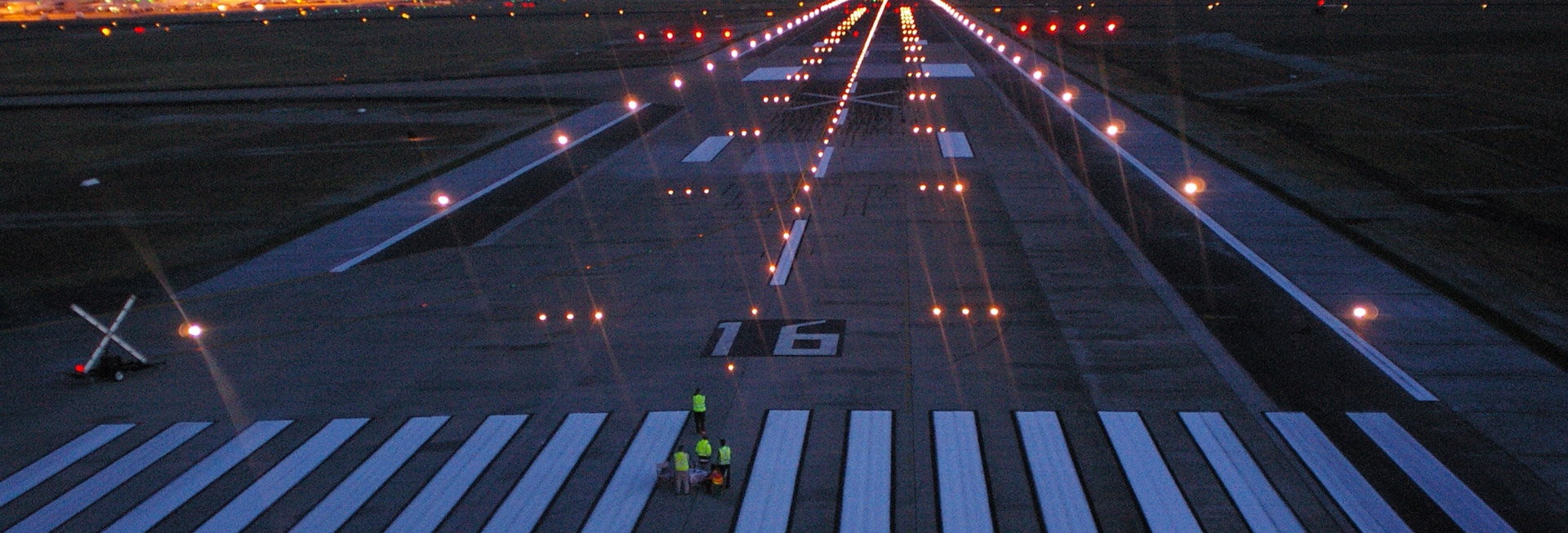Blog


Maintaining Airfield Lighting Systems: Best Practices
Airfield lighting systems play a critical role in ensuring the safe operation of airports, particularly in low-visibility conditions and at night. Proper maintenance of airfield lighting is essential to keep the system functioning optimally and to prevent costly disruptions or accidents. In this blog, we’ll explore best practices for maintaining airfield lighting systems to enhance safety and efficiency.
1. Regular Inspections
Frequent inspections are key to maintaining the reliability of airfield lighting systems. Routine checks help identify potential issues early, such as faulty lights, damaged fixtures, or wear and tear from weather.
- Daily Visual Inspections: Check airfield lighting for burnt-out bulbs, misaligned lights, or broken fixtures.
- Monthly Testing: Conduct functional tests to ensure that all airfield lighting components are operational and that control systems are working correctly.
This proactive approach helps prevent minor issues from escalating into major problems that could compromise safety or require costly repairs.
2. Cleaning and Debris Removal
Airfield lighting is exposed to the elements, making lights prone to dirt, dust, and debris accumulation. Regular cleaning ensures optimal brightness and visibility for pilots.
- Cleaning Lenses: Dirty lenses reduce light output. Regular cleaning, especially after storms, ensures maximum brightness from your airfield lighting system.
- Debris Clearing: Remove any debris, such as grass, snow, or leaves, that could obstruct airfield lighting or affect performance.
Keeping airfield lighting clean and clear of obstructions ensures that it provides the maximum illumination required for safe airport operations, especially during low-visibility conditions.
3. Scheduled Maintenance and Replacements
Airfield lighting systems, especially those using older technologies like halogen bulbs, require periodic replacements to ensure continuous functionality.
- Replace Burnt-Out Bulbs: Replacing any non-operational airfield lighting promptly maintains the system’s overall effectiveness and compliance with safety regulations.
- Upgrade to LED Systems: Consider upgrading to LED airfield lighting, which lasts longer, uses less energy, and requires less maintenance than traditional bulbs.
Having a clear schedule for checking and replacing airfield lighting components can prevent unexpected outages and improve the system’s overall performance.
4. Monitor Power Supply and Wiring
Airfield lighting depends on a stable power supply and well-maintained wiring. Regular checks can prevent outages and ensure smooth operation.
- Check Power Systems: Monitor for voltage fluctuations or power losses that could impact the airfield lighting system. Backup power sources, like generators, should be tested regularly to ensure they activate when needed.
- Inspect Wiring: Regularly check airfield lighting wiring for signs of corrosion, damage, or wear, and replace wiring as necessary to avoid outages.
Ensuring the power supply and wiring for airfield lighting are in good condition helps maintain consistent performance and prevents operational disruptions.
5. Adopt a Preventative Maintenance Approach
Preventative maintenance is essential for extending the lifespan of your airfield lighting system and reducing the frequency of costly repairs.
- Routine Checks: Perform routine checks on high-stress components such as lighting transformers, cabling, and control systems.
- Test Control Systems: Regularly test airfield lighting control systems to ensure smooth operation, especially during night operations or low-visibility conditions.
A proactive, preventative maintenance program ensures that airfield lighting operates at peak efficiency year-round.
6. Maintain Compliance with Regulations
International aviation authorities like the ICAO and FAA have stringent guidelines for airfield lighting maintenance. Staying compliant ensures safety and avoids regulatory penalties.
- Follow ICAO/FAA Standards: Regularly update maintenance procedures to align with the latest airfield lighting safety guidelines.
- Document Maintenance Activities: Keep thorough records of all inspections, maintenance, and repairs to demonstrate compliance with regulations.
Proper record-keeping also helps identify recurring issues in your airfield lighting system, allowing for more targeted maintenance.
7. Utilize Smart Monitoring Systems
Advancements in airfield lighting technology offer the ability to remotely monitor and control lighting systems.
- Smart Monitoring: These systems can detect faults in airfield lighting in real-time, allowing for quicker response times and reducing the chances of system-wide failures.
- Remote Control: Many modern airfield lighting systems allow for remote adjustments of light intensity and configuration, improving efficiency and reducing the need for manual intervention.
Investing in smart systems can streamline airfield lighting maintenance and reduce operational downtime.
Conclusion
Proper maintenance of airfield lighting systems is crucial for ensuring airport safety, minimizing disruptions, and maintaining compliance with regulations. Regular inspections, cleaning, and proactive component replacements can significantly extend the lifespan of airfield lighting systems, reduce costs, and ensure safe airport operations.
At Aviasafe, we specialize in providing advanced airfield lighting solutions and expert maintenance services. Whether you’re looking to upgrade your current airfield lighting system or optimize maintenance procedures, our team is here to help ensure the long-term reliability of your airfield lighting system.

Subscribe Now!
Our Newsletter
Don't worry, we hate spam too - that's why we only send out monthly emails.